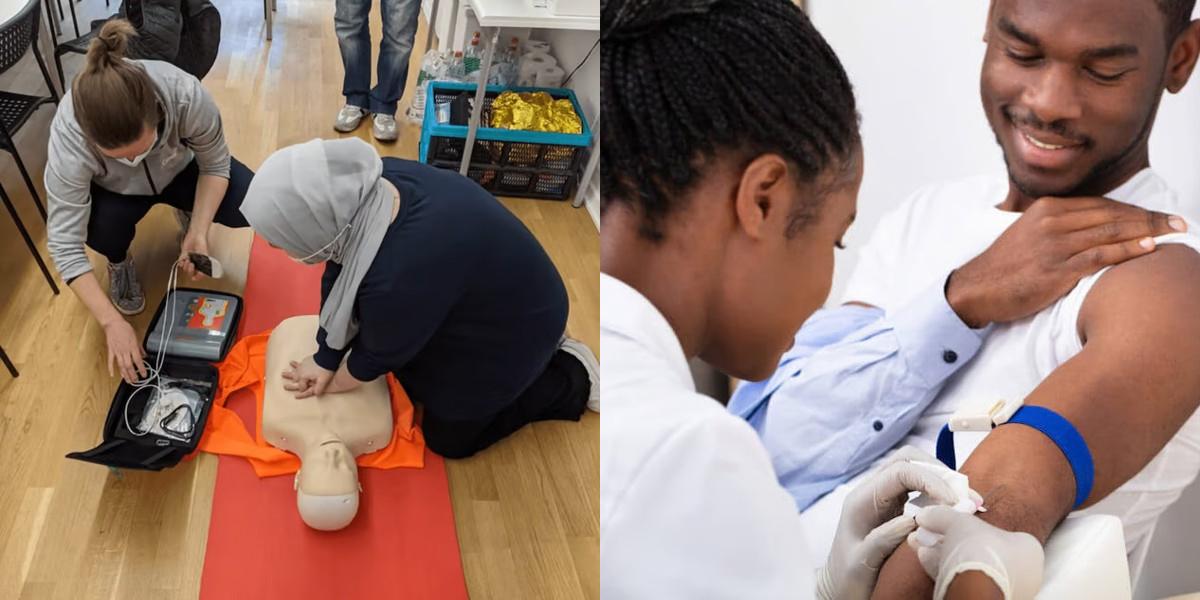CPR-BLS vs Phlebotomy

Key Points:
- CPR-BLS providers perform emergency medical care, while Phlebotomists collect blood samples for testing.
- CPR-BLS providers typically earn more than Phlebotomists.
- Both fields have growing job opportunities.
- CPR-BLS training is often available online and in-person, while Phlebotomy training is typically in-person.
- CPR-BLS training is generally less expensive and takes less time (typically a few hours) compared to Phlebotomy training.
CPR-BLS and phlebotomy are two different vocations that both play a crucial role in the healthcare industry. If you are considering a healthcare career, it is important to understand the differences between these two professions so that you can choose the path that best suits your interests and goals. This blog post will provide an overview of CPR-BLS and phlebotomy, highlight the key differences between them, and explore the job description, education and training, and career outlook and salary for each.
CPR-BLS vs Phlebotomy: Education and Training
The education and training requirements for CPR-BLS and phlebotomy professionals differ as well:
CPR-BLS Education and Training:
- CPR-BLS certification courses are offered by various organizations, including the American Heart Association and the Red Cross.
- These courses typically cover topics such as basic life support techniques, CPR for adults, children, and infants, and the use of AEDs.
- The duration of CPR-BLS courses can vary, but they often range from a few hours to a full day.
- Healthcare professionals may also receive CPR-BLS training as part of their formal education programs.
Phlebotomy Education and Training:
- Phlebotomy training programs are offered by vocational schools, community colleges, and healthcare organizations.
- These programs typically include both classroom instruction and hands-on clinical experience.
- The curriculum covers topics such as venipuncture techniques, anatomy and physiology, medical terminology, and infection control.
- The duration of phlebotomy training programs can vary, but they often range from a few weeks to several months.
- After completing a phlebotomy training program, individuals may need to pass a certification exam to become a certified phlebotomist.
CPR-BLS vs Phlebotomy: Career Outlook and Salary
The career outlook and salary for CPR-BLS and phlebotomy professionals can vary based on factors such as location, experience, and employer:
CPR-BLS Career Outlook and Salary:
- The demand for healthcare professionals with CPR-BLS certification is expected to remain high, as emergency situations can occur in various settings.
- CPR-BLS professionals may find employment in hospitals, clinics, schools, fitness centers, and other healthcare facilities.
- According to the Bureau of Labor Statistics, the median annual wage for emergency medical technicians (EMTs) and paramedics, who often have CPR-BLS certification, was $35,400 in May 2020.
Phlebotomy Career Outlook and Salary:
- The demand for phlebotomists is projected to grow as the healthcare industry continues to expand.
- Phlebotomists can find employment in hospitals, laboratories, blood banks, and other healthcare settings.
- According to the Bureau of Labor Statistics, the median annual wage for phlebotomists was $36,320 in May 2020.
Final Thoughts
CPR-BLS and phlebotomy are two distinct vocations within the healthcare industry, each with its own unique set of responsibilities, education and training requirements, and career outlook. If you are interested in providing immediate care in emergency situations, CPR-BLS may be the right choice for you. On the other hand, if you enjoy working with patients and have an interest in laboratory procedures, phlebotomy may be a better fit. Ultimately, the decision between CPR-BLS and phlebotomy depends on your personal interests, goals, and strengths.
Dreambound's educational programs are conveniently available in diverse locations, ensuring accessibility for aspiring individuals. For a more comprehensive understanding of the exciting opportunities within the realms of these two vocations, we invite you to explore further details by visiting:



